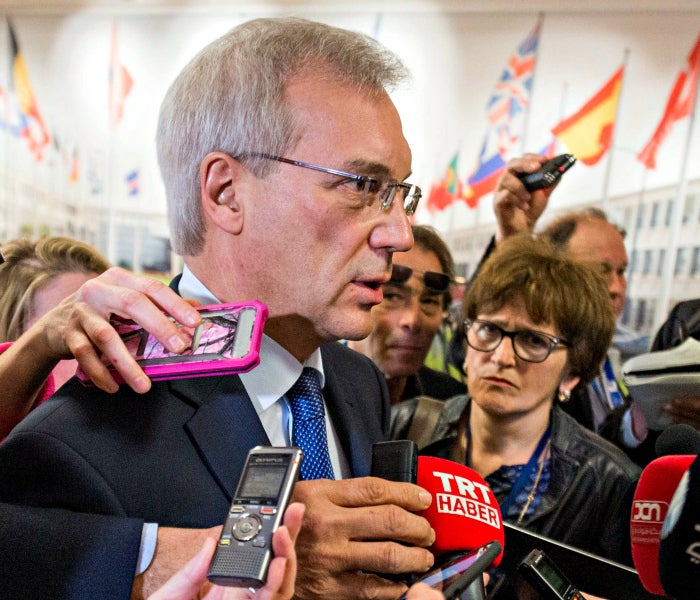Obstruction of a government process and investigation. That is a violation of the law. Hillary, what say you and your team? Ever notice that the Democrats never ask questions or complain about lack of compliance or cooperation?
Exactly how many had access to Hillary’s office or permission to remove files? Ahem….
State Department Office Removed Benghazi Files After Congressional Subpoena
FreeBeacon: State Department officials removed files from the secretary’s office related to the Benghazi attack in Libya and transferred them to another department after receiving a congressional subpoena last spring, delaying the release of the records to Congress for over a year.
Attorneys for the State Department said the electronic folders, which contain hundreds of documents related to the Benghazi attack and Libya, were belatedly rediscovered at the end of last year.
They said the files had been overlooked by State Department officials because the executive secretary’s office transferred them to another department and flagged them for archiving last April, shortly after receiving a subpoena from the House Select Committee on Benghazi.
The new source of documents includes electronic folders used by senior officials under Secretary of State Hillary Clinton. They were originally kept in the executive secretary’s office, which handles communication and coordination between the secretary of state’s office and other department bureaus.
The House Benghazi Committee requested documents from the secretary’s office in a subpoena filed in March 2015. Congressional investigators met with the head of the executive secretary’s office staff to discuss its records maintenance system and the scope of the subpoena last April. That same month, State Department officials sent the electronic folders to another bureau for archiving, and they were not searched in response to the request.
The blunder could raise new questions about the State Department’s records process, which has come under scrutiny from members of Congress and government watchdogs. Sen. Chuck Grassley (R., Iowa), chairman of the Senate Judiciary Committee, blasted the State Department’s Freedom of Information Act process as “broken” in January, citing “systematic failures at the agency.”
The inspector general for the State Department also released a report criticizing the agency’s public records process in January. The report highlighted failures in the executive secretary’s office, which responds to records requests for the Office of the Secretary.
Since last fall, the State Department has taken additional steps to increase transparency, recently hiring a transparency coordinator.
But the late discovery of the electronic folders has set back the release of information in a number of public records lawsuits filed against the State Department by watchdog groups.
The State Department first disclosed that staffers had discovered the unsearched folders in a January court filing. Attorneys for the department asked the court for additional time to process and release the documents in response to a 2014 lawsuit filed by the government ethics group Judicial Watch.
Around the same time, the State Department alerted the House Select Committee on Benghazi to the discovery. On April 8, the department turned over 1,100 pages of documents from the electronic folders to the House Benghazi Committee, over a year after the committee’s subpoena. The committee had received other documents from the production in February.
The delay has had consequences. The Benghazi Committee had already completed the majority of its interviews with diplomats and government officials regarding the Benghazi attack before it received the latest tranche of documents.
Rep. Trey Gowdy (R., S.C.), chairman of the Benghazi Committee, said in an April 8 statement it was “deplorable that it took over a year for these records to be produced to our committee.”
“This investigation is about a terrorist attack that killed four Americans, and it could have been completed a lot sooner if the administration had not delayed and delayed and delayed at every turn,” Gowdy said.
The decision by State Department officials to transfer the electronic folders to another bureau after receiving the subpoena could also raise questions.
The subpoena requested Benghazi-related documents and communications from 10 of Hillary Clinton’s top aides for the years 2011 and 2012.
The requests included standard language that “Subpoenaed records, documents, data or information should not be destroyed, modified, removed, transferred or otherwise made inaccessible to the Committee.”
The State Department’s attorneys said the executive secretary’s office transferred the folders to the Office of Information Programs and Services for “retiring” in April 2015. Public records officials did not realize for almost eight months that the folders had been moved, and so they were not searched in response to FOIA requests or subpoenas.
“In April 2015—prior to its search in this [Judicial Watch] case—the Secretariat Staff within the Office of the Executive Secretariat (“S/ES-S”) retired the shared office folders and transferred them to the custody of the Bureau of Administration, Office of Information Programs and Services,” the State Department said in a Feb. 5 court filing.
“The IPS employees working on this FOIA request did not initially identify S/ES retired records as a location to search for potentially responsive records because they were operating with the understanding that, to the extent responsive records from the Office of the Secretary existed, they resided within [the executive secretary’s office].”
According to congressional sources, officials on the House Benghazi Committee had a meeting with the executive secretary’s office to discuss the subpoena and the locations of potentially relevant records on April 10, 2015. Electronic folders of senior staff members were discussed during the briefing.
State Department officials at the meeting included the director of the executive secretary’s office staff, who was responsible for handling the office’s records maintenance, the assistant secretary for legislative affairs, and Catherine Duval, the attorney who oversaw the public release of Hillary Clinton’s official emails. The officials gave no indication that electronic folders had recently been transferred out of the office.
The State Department declined to comment on whether the folders were transferred after the meeting took place.
A State Department official told the Washington Free Beacon that personnel did not mislead congressional investigators, and added that no officials at the meeting were involved in transferring the folders.
“The Department personnel who briefed the Select Committee in April 2015 did not play a role in the transfer of these files to State’s Bureau of Administration,” the State Department official said.
The official added that department files are often moved as a routine matter.
“Files that are generated in an office are regularly moved to the Bureau of Administration for storage according to published records retirement schedules,” the official said. “This is a routine action that would not involve a senior supervisor. It also continues to make them available to respond to either Congressional or FOIA requests.”
Duval left the State Department last September. She had previously overseen document production for the IRS during the targeting controversy. Republicans had criticized that process after agency emails were reportedly destroyed and a key IRS official’s hard drive was shredded months after they had been subpoenaed by Congress.
In recent months, the State Department has been working to increase transparency.
“The Department has worked closely with the Select Committee in a spirit of cooperation and responsiveness,” a State Department official said. “Since the Committee was formed, we have provided 48 witnesses for interviews and more than 95,000 pages of documents.”
The efforts drew some praise from the House Benghazi Committee last fall.
“It’s curious the Department is suddenly able to be more productive after recent staff changes involving those responsible for document production,” committee spokesman Jamal Ware said in a Sept. 25, 2015 press release.
Still, it could be months before the public is able to see many of the Benghazi-related documents belatedly discovered by the State Department. The House Benghazi Committee is still completing its investigation and has not released them.
The department’s attorneys have also been granted extensions to produce the documents in response to several public records lawsuits. In one FOIA case, first filed by the watchdog group Citizens United in 2014, a judge has given the State Department until next August to turn over the new materials.
Correction: The original version of this article stated that the House Select Committee on Benghazi had submitted two subpoenas to the State Department. The Committee only submitted one subpoena, on March 4, 2015. The November 2014 request was an official letter from the Committee to Secretary John Kerry.








 Today, Obama in Erga Palace, Riyadh
Today, Obama in Erga Palace, Riyadh